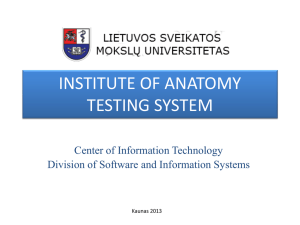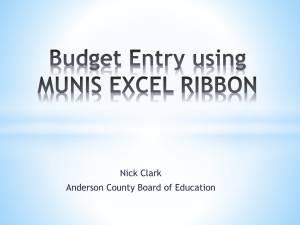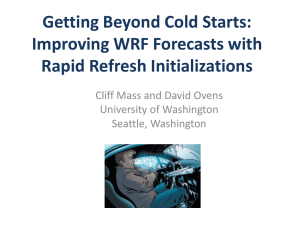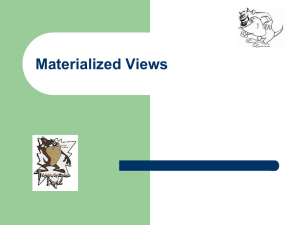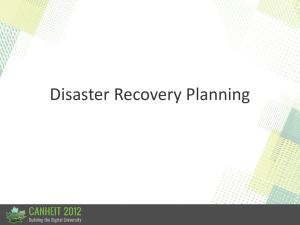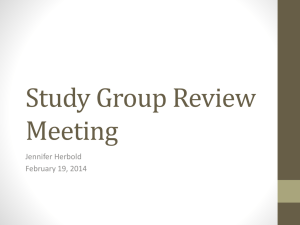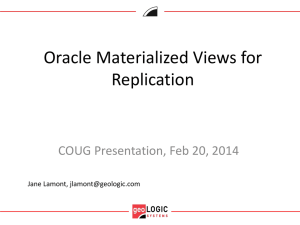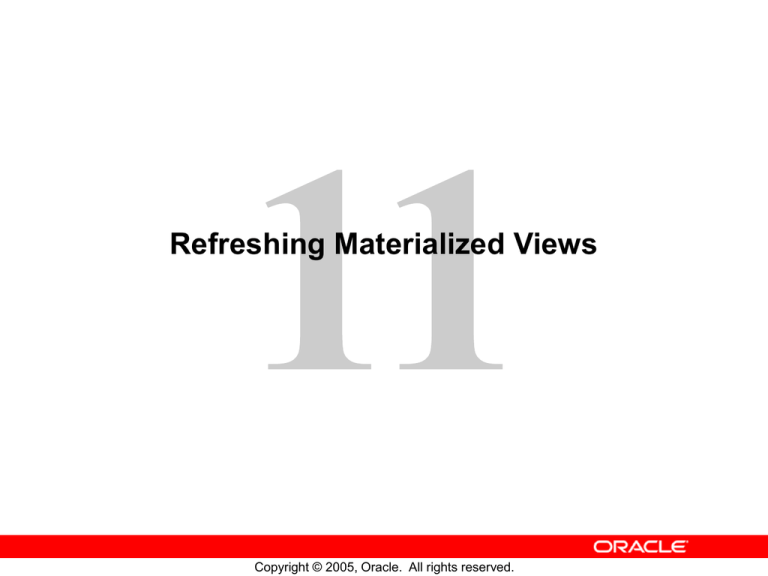
Refreshing Materialized Views
Copyright © 2005, Oracle. All rights reserved.
Objectives
After completing this lesson, you should be able to do
the following:
• Describe the various refresh methods and modes
• Refresh materialized views
• Create fast-refreshable materialized views
• Explain why materialized views cannot be fast
refreshable
• Create materialized view logs
• Describe the benefit of Partition Change Tracking
• Use parallel refreshes
11-2
Copyright © 2005, Oracle. All rights reserved.
Refresh Options
Refresh options specified when the materialized view
is created:
• COMPLETE: Re-executes query
• FAST: Refresh is based on delta
– Using materialized view logs
– Using direct loader log: ALL_SUMDELTA
– Using Partition Change Tracking refresh
•
•
11-3
FORCE: FAST if possible, otherwise COMPLETE
NEVER
Copyright © 2005, Oracle. All rights reserved.
Refresh Modes
Refresh execution modes specified when the
materialized view is created:
• ON DEMAND: Manual refresh using procedures in
DBMS_MVIEW package (default)
• ON COMMIT: Refresh performed at transaction
commit
– Only possible for fast-refreshable materialized
views
– ON COMMIT REFRESH object privilege needed
– In case of failure, subsequent refreshes are manual
11-5
Copyright © 2005, Oracle. All rights reserved.
Refresh at Scheduled Time
Schedule refresh at materialized view creation time
with START WITH and NEXT:
CREATE MATERIALIZED VIEW emp_data_mv …
REFRESH FAST NEXT sysdate + 7 …
CREATE MATERIALIZED VIEW cust_data_mv …
REFRESH START WITH ROUND(SYSDATE + 1) + 11/24
NEXT NEXT_DAY(TRUNC(SYSDATE),'MONDAY')+ 15/24
…
11-6
Copyright © 2005, Oracle. All rights reserved.
Manual Refresh Using DBMS_MVIEW
•
•
For ON DEMAND refresh
Three procedures in the DBMS_MVIEW package:
– REFRESH
– REFRESH_ALL_MVIEWS
– REFRESH_DEPENDENT
•
The refresh can be performed by:
– Foreground session, if no job queue process is
started
– One or multiple job queue processes, if
JOB_QUEUE_PROCESSES is set
– Multiple refresh, which can be done in parallel
11-7
Copyright © 2005, Oracle. All rights reserved.
Refresh Specific Materialized Views
with REFRESH
exec DBMS_MVIEW.REFRESH('MV1,MV2','FC','',FALSE,TRUE,0,0,0,FALSE);
Refresh each in a
separate
Continue when
transaction
there are errors
Do not push
changes
Refresh method
for each
List of
materialized views
11-9
Copyright © 2005, Oracle. All rights reserved.
Refresh All Materialized Views with
REFRESH_ALL_MVIEWS
VARIABLE fail NUMBER;
exec DBMS_MVIEW.REFRESH_ALL_MVIEWS(:fail, 'C','', TRUE, FALSE);
Continue when
there are errors
Refresh method
for each
Refresh each in a
separate
transaction
Returns number
of failed refreshes
11-11
Copyright © 2005, Oracle. All rights reserved.
Refresh Dependent Materialized Views
with REFRESH_DEPENDENT
Refresh all materialized views directly depending on a
list of detail tables or materialized views:
VARIABLE fail NUMBER;
exec DBMS_MVIEW.REFRESH_DEPENDENT(:fail,'CUSTOMERS,SALES','CF','',TRUE, FALSE);
Continue when
there are errors
Refresh method
Refresh each in a
List of
for each
separate
materialized views
transaction
11-12
Copyright © 2005, Oracle. All rights reserved.
Finding Dependent Materialized Views
•
•
Find direct dependencies only.
Can be used to determine the materialized view
refresh order for nested materialized views
VARIABLE deplist VARCHAR2(500)
exec DBMS_MVIEW.GET_MV_DEPENDENCIES('CUSTOMERS,SALES',:deplist);
List of
materialized views
11-13
Returns list of
dependent
materialized views
Copyright © 2005, Oracle. All rights reserved.
When Does a Complete Refresh Occur?
•
•
•
11-14
Initial build of the materialized view (BUILD
IMMEDIATE)
First refresh for BUILD DEFERRED materialized
views
Manual request
Copyright © 2005, Oracle. All rights reserved.
Conditions That Effect Possibility of
Fast Refresh
•
•
•
•
11-15
Existence of materialized view logs
Materialized view’s detail query
Types of modifications made to the detail tables
Sequence of modifications made to the detail
tables
Copyright © 2005, Oracle. All rights reserved.
Explain Materialized View
•
DBMS_MVIEW.EXPLAIN_MVIEW accepts:
– Materialized view name, or
– SQL statement
•
Advises what is possible for:
– An existing materialized view
– A potential materialized view before you create it
•
•
11-16
Results are stored in MV_CAPABILITIES_TABLE
(relational table) or in a VARRAY.
utlxmv.sql must be executed as the current user
to create MV_CAPABILITIES_TABLE.
Copyright © 2005, Oracle. All rights reserved.
Using DBMS_MVIEW.EXPLAIN_MVIEW
EXEC dbms_mview.explain_mview('sales_sum', '123');
SELECT capability_name, possible, related_text,
msgtxt
FROM mv_capabilities_table
WHERE statement_id = '123' ORDER BY seq;
CAPABILITY_NAME
P REL_TEXT MSGTXT
---------------- -------- --------------------…
REFRESH_COMPLETE
Y
REFRESH_FAST
N
REFRESH_FAST_AFTER_INSERT
N TIMES
mv log must have new
values
…
11-17
Copyright © 2005, Oracle. All rights reserved.
Materialized View Logs: General Concepts
•
•
•
•
Definition: Table that contains rows describing
changes made to a detail table
The logs are required if fast refresh is used.
Log definition must include the WITH ROWID
clause.
For joins and aggregate materialized views to be
fast-refreshable after INSERTs, logs must include:
– Every column referenced in the materialized view
– The INCLUDING NEW VALUES clause
•
•
11-18
An INSERT, UPDATE, DELETE combination on
multiple detail tables requires the log to include
the SEQUENCE clause.
SEQUENCE provides ordering information.
Copyright © 2005, Oracle. All rights reserved.
Creating a Materialized View Log
CREATE MATERIALIZED VIEW LOG ON sh.sales
TABLESPACE users
NOLOGGING
PARALLEL
WITH SEQUENCE, ROWID
(quantity_sold,amount_sold)
INCLUDING NEW VALUES;
11-19
Copyright © 2005, Oracle. All rights reserved.
Restrictions for Fast-Refreshable
Materialized Views
•
General restrictions:
– No non-repeating expressions
– No references to RAW or LONG RAW data types
– Support for subqueries in the WHERE clause limited
to data subsetting (WHERE EXISTS)
•
11-20
Additional restrictions apply for specific types of
materialized views.
Copyright © 2005, Oracle. All rights reserved.
Indexes and Fast-Refreshable
Materialized Views
•
Fast refresh joins and aggregate materialized view
– The Oracle server automatically creates a unique
functional index on a materialized view’s keys for
better fast refresh performance.
– Index expression: SYS_OP_MAP_NONNULL(keyn)
– USING [NO] INDEX clause at creation time
•
Fast refresh joins-only materialized view
– No index is automatically created.
– For better fast refresh performance, create an index
on row ID columns of the select list.
11-21
Copyright © 2005, Oracle. All rights reserved.
Specifying REFRESH FORCE
•
Materialized view may be fast refreshable in some,
but not all cases.
– Joins-only materialized view without row IDs from
one of its detail tables can still be fast refreshed
whenever updating only the other detail tables.
– Should be exception and should not be generalized
•
•
11-22
Use REFRESH FORCE option during creation to
ensure fast refresh whenever possible.
Query DBA_MVIEWS.FAST_REFRESHABLE to
determine whether the materialized view is eligible
for fast refresh.
Copyright © 2005, Oracle. All rights reserved.
Partition Change Tracking (PCT) Refresh
•
•
Fast refresh uses materialized view log or directloader log.
Certain cases prevent using a materialized view
log thus preventing general fast refresh.
– Dropping of a detail table’s partition
– Mixed DML when the materialized view uses the MIN
function
•
Maintain staleness at partition level:
– Only detected for partitioned detail tables
– Only specific sections of the materialized view need
to be refreshed
– Rows corresponding to impacted partitions only
– Should be faster than a complete refresh
11-24
Copyright © 2005, Oracle. All rights reserved.
PCT Refresh Requirements
•
One of the materialized view detail tables must be
partitioned: RANGE, COMPOSITE, or LIST.
•
•
Partition key must consist of a single column.
SELECT and GROUP BY list must contain: partition
key column, partition marker
(DBMS_MVIEW.PMARKER), ROWID, or join-dependent
expression of one of its detail tables.
No reference to views or outer joins
•
11-25
Copyright © 2005, Oracle. All rights reserved.
When Is PCT Refresh Used?
•
•
•
•
Fast refresh is requested, and
A detail table is partitioned, and
PCT refresh is possible for the materialized view,
and
One or both of the following two conditions have
occurred on detail tables:
– Partition DDL operations
– Combinations of DML/direct-loads not handled by
fast refresh
•
•
11-26
Requested using P parameter with refresh
procedures
FAST_PCT is indicated in LAST_REFRESH_TYPE.
Copyright © 2005, Oracle. All rights reserved.
Partition Key or Partition Marker?
CREATE MATERIALIZED VIEW cost_product_mv
(tid, pname, su, cu, cnt)
BUILD IMMEDIATE REFRESH FAST ON DEMAND
ENABLE QUERY REWRITE AS
SELECT time_id, prod_name, SUM(unit_cost),
COUNT(unit_cost), COUNT(*)
FROM sh.costs c, sh.products p
WHERE c.prod_id = p.prod_id
GROUP BY time_id, prod_name;
Cardinality = #part_keys x distinct(prod_name)
11-27
Copyright © 2005, Oracle. All rights reserved.
Partition Key or Partition Marker?
CREATE MATERIALIZED VIEW cost_product_pm_mv
(pm, pname, su, cu, cnt)
BUILD IMMEDIATE REFRESH FAST ON DEMAND
ENABLE QUERY REWRITE AS
SELECT DBMS_MVIEW.PMARKER(c.rowid),
prod_name, SUM(unit_cost),
COUNT(unit_cost), COUNT(*)
FROM costs c, products p
WHERE c.prod_id = p.prod_id
GROUP BY DBMS_MVIEW.PMARKER(c.rowid),
prod_name;
Cardinality = #partitions x distinct(prod_name)
11-28
Copyright © 2005, Oracle. All rights reserved.
PCT Using ROWID
CREATE MATERIALIZED VIEW pct_rowid_mv
(srid, prid, cid, pname)
BUILD IMMEDIATE
REFRESH FORCE
ENABLE QUERY REWRITE
AS
SELECT s.rowid, p.rowid,
s.channel_id, p.prod_name
FROM
sales s, products p
WHERE s.prod_id = p.prod_id;
11-29
Copyright © 2005, Oracle. All rights reserved.
Consider Fresh: Fastest Refresh Scenario
1
2
Drop partition
3
ALTER MATERIALIZED VIEW CONSIDER FRESH
Fact
11-30
MV
Copyright © 2005, Oracle. All rights reserved.
CONSIDER FRESH Refresh Implications
•
STALENESS column of DBA_MVIEWS set to
UNKNOWN until next complete refresh
•
Until next complete refresh, PCT refresh no longer
possible
Fast refresh still possible
•
11-31
Copyright © 2005, Oracle. All rights reserved.
General Tips for Materialized View Refresh
•
For complete refresh using DBMS_MVIEW interface,
set ATOMIC_REFRESH to FALSE.
•
Disable materialized view logging before
refreshing (NOLOGGING).
Always check alert.log and trace files after a
refresh.
Try to perform only one type of change before
refreshing.
Try to refresh directly after one table load.
For ON COMMIT refresh, try to group DMLs in one
single transaction or use short transactions.
•
•
•
•
11-32
Copyright © 2005, Oracle. All rights reserved.
Refresh Tips for Nested Materialized Views
•
For ON DEMAND refresh:
– You must refresh in the correct order.
– Refresh is based on detail materialized views
independently of their STALENESS.
•
For ON COMMIT refresh (simple joins or singletable aggregate):
– Appropriate refresh order is automatically used.
– In case of problem, you must refresh manually.
11-33
Copyright © 2005, Oracle. All rights reserved.
Summary
In this lesson, you should have learned how to:
• Create materialized views with different refresh
methods and modes
• Use the DBMS_MVIEW package to refresh
materialized views
• Use the DBMS_MVIEW package to explain
materialized views
• Create materialized view logs
• Create materialized views supporting PCT
11-34
Copyright © 2005, Oracle. All rights reserved.
Practice 11: Overview
This practice covers the following topics:
• Using various refresh types:
– COMPLETE
– FAST
– FAST_PCT
•
•
11-35
Explaining materialized view refresh capabilities
Creating materialized view logs
Copyright © 2005, Oracle. All rights reserved.

